
The Uffizi Gallery is a prominent art museum located adjacent to the Piazza della Signoria in the Historic Centre of Florence in the region of Tuscany, Italy. One of the most important Italian museums and the most visited, it is also one of the largest and best known in the world and holds a collection of priceless works, particularly from the period of the Italian Renaissance.

Arona is a town and comune on Lake Maggiore, in the province of Novara. Its main economic activity is tourism, especially from Milan, France and Germany.

The Palazzo Pitti, in English sometimes called the Pitti Palace, is a vast, mainly Renaissance, palace in Florence, Italy. It is situated on the south side of the River Arno, a short distance from the Ponte Vecchio. The core of the present palazzo dates from 1458 and was originally the town residence of Luca Pitti, an ambitious Florentine banker.

The Albertina is a museum in the Innere Stadt of Vienna, Austria. It houses one of the largest and most important print rooms in the world with approximately 65,000 drawings and approximately 1 million old master prints, as well as more modern graphic works, photographs and architectural drawings. Apart from the graphics collection the museum has recently acquired on permanent loan two significant collections of Impressionist and early 20th-century art, some of which will be on permanent display. The museum also houses temporary exhibitions. The museum had 360,073 visitors in 2020, down 64 percent from 2019 due to the COVID-19 pandemic, but still ranked 55th in the List of most-visited art museums in the world.

The Palazzo della Cancelleria is a Renaissance palace in Rome, Italy, situated between the present Corso Vittorio Emanuele II and the Campo de' Fiori, in the rione of Parione. It was built 1489–1513 by Baccio Pontelli and Antonio da Sangallo the Elder as a palace for Cardinal Raffaele Riario, Camerlengo of the Holy Roman Church, and is regarded as the earliest Renaissance palace in Rome. The Palazzo houses the Papal Chancellery, is an extraterritorial property of the Holy See, and is designated as a World Heritage Site.
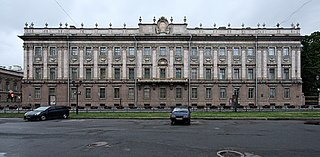
Marble Palace is one of the first Neoclassical palaces in Saint Petersburg, Russia. It is situated between the Field of Mars and Palace Quay, slightly to the east from New Michael Palace.

The Palazzo Massimo alle Colonne is a Renaissance palace in Rome, Italy. The palace was designed by Baldassarre Peruzzi in 1532–1536 on a site of three contiguous palaces owned by the old Roman Massimo family and built after arson destroyed the earlier structures during the Sack of Rome (1527). In addition the curved facade was dictated by foundations built upon the stands for the stadium (odeon) of the emperor Domitian. It fronts the now-busy Corso Vittorio Emanuele II, a few hundred yards from the front of the church of Sant'Andrea della Valle.

The Museo Lombardi is a museum displaying an eclectic collection of 19th-century art and cultural works from Parma. It is located in the Palazzo di Riserva on Strada Garibaldi #5 in central Parma, Emilia-Romagna, Italy.
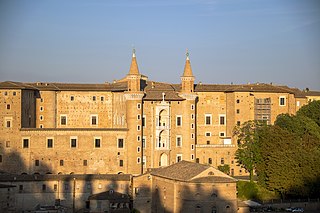
The Ducal Palace is a Renaissance building in the Italian city of Urbino in the Marche. One of the most important monuments in Italy, it is listed as UNESCO World Heritage Site since 1998.

Palazzo Mozzi or Palazzo de' Mozzi is an early Renaissance palace, located at the end of the Piazza de' Mozzi that emerges from Ponte alle Grazie and leads straight to the palace where via San Niccolò becomes via de' Bardi in the Quartiere of Santo Spirito in the Oltrarno section of Florence, region of Tuscany, Italy. The 13th-century palace housed the gallery of the highly successful antiquarian Stefano Bardini, of which the remnants were left to the commune, where they assembled the Museo Bardini or Mozzi Bardini, displaying Florentine art and artifacts up to the early Renaissance. The gardens elaborated against the hillside behind the palace were added mainly by Bardini.

Palazzo Bianco is one of the main buildings of the center of Genoa, Italy. It is situated at 11, via Garibaldi.

The Palazzo Colonna is a palatial block of buildings in central Rome, Italy, at the base of the Quirinal Hill, and adjacent to the church of Santi Apostoli. It is built in part over the ruins of an old Roman serapeum, and it has belonged to the prominent Colonna family for over twenty generations.

The Palazzo Buonaccorsi is an 18th-century aristocratic palace, now the civic museum of the town, located on Via Don Minzoni 24 in the historic center of Macerata, region of Marche, Italy.

The Musée du Petit Palais is a museum and art gallery in Avignon, southern France. It opened in 1976 and has an exceptional collection of Renaissance paintings of the Avignon school as well as from Italy, which reunites many "primitives" from the collection of Giampietro Campana. It is housed in a 14th-century building at the north side of the square overlooked by the Palais des Papes. The building, built in the early 14th century as the residence of the bishops of Avignon, was made a UNESCO World Heritage Site as part of the historic center of Avignon in 1995.
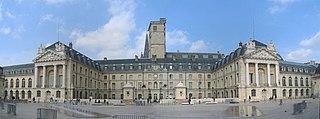
The Musée des Beaux-Arts de Dijon is a museum of fine arts opened in 1787 in Dijon, France. It is one of the main and oldest museums of France. It is located in the historic city centre of Dijon and housed in the former ducal palace which was the headquarters of the Burgundy State in the 15th century. When the duchy was assimilated to the Kingdom of France, the palace became the house of the King. In the 17th century it became the Palace of the Dukes of Burgundy following a project by Jules Hardouin-Mansart.

The Sancta Sanctorum is a Roman Catholic chapel entered via the Scala Sancta of the Lateran Palace in Rome. It was the original private chapel of the papacy before it moved to Avignon, and later to the Vatican Palace. The chapel is the only building from the old Lateran Palace that was not destroyed during its reconstruction.
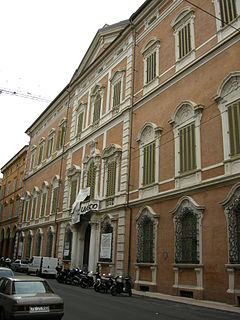
The Palazzo Aldovrandi is a Senatorial palace on Via Galliera 8 in Bologna, built in Rococo style.

The Galleria d'Arte Moderna is a modern art museum in Milan, in Lombardy in northern Italy. It is housed in the Villa Reale, at Via Palestro 16, opposite the Giardini Pubblici. The collection consists largely of Italian and European works from the 18th to the 20th centuries.

The Royal Armoury of Turin is one of the world’s most important collections of arms and armour, formed in Turin by the Savoy family. The museum is now part of the Musei Reali di Torino, the royal site that has unified the Royal Palace, the Sabauda Gallery, the Archaeological Museum, the Royal Library and the Armoury. The whole site has been included on the UNESCO World Heritage list since 1997.
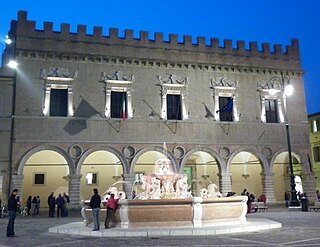
The Palazzo Ducale di Pesaro or Ducal Palace of Pesaro is a Renaissance-style palace in the city center of Pesaro, region of the Marche, Italy.





















